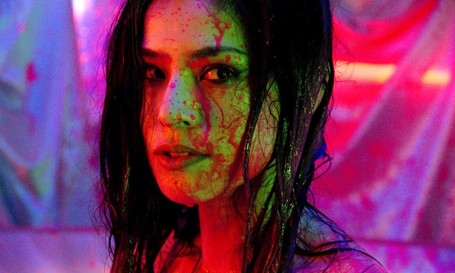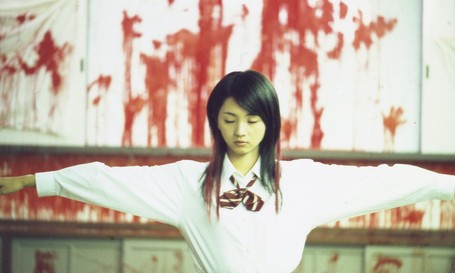Archiwum - 10. Festiwal Filmowy Pięć Smaków
Portret: Sion Sono
Sion Sono: portret buntownika
Sion Sono to jeden z najważniejszych i najbardziej wpływowych głosów współczesnego japońskiego kina. Niezależny, łamiący zasady twórca od lat zgłębia mroczne strony japońskiej psyche, z rozmachem sięgając po najmocniejsze formy i najbardziej skrajne konwencje: od mrocznej groteski i popkulturowego szaleństwa po surowy, wysmakowany minimalizm. W programie sekcji znalazło się sześć filmów z różnych okresów twórczości reżysera oraz unikatowy dokument, odsłaniający także jego mniej znane oblicza.


Reżyser, performer, scenarzysta, poeta, malarz i muzyk, który dziś ma na swoim koncie niemal 50 tytułów, zaczynał od realizowanego bez budżetu kina offowego, określanego w Japonii mianem jishu eiga. Jego wczesne, rejestrowane na taśmie 8mm filmy to surowy zapis młodzieńczego buntu - ale nie tylko: za rozedrganymi, punkowymi kadrami skrywa się także ogromna wrażliwość i rozsadzająca scenariuszowe ramy, pełna pasji miłość do kina. W "Jestem Sion Sono!" młody autor kieruje kamerę na samego siebie, w egocentryczny pamiętnik wplatając jednak intrygujące eksperymenty formalne. W "Scenie życia" bawi się mangowymi konwencjami i nawiązaniami do filmów o potworach, splatając z nimi uderzająco szczery obraz własnej rodziny. Obydwa filmy zostały docenione na najważniejszym przeglądzie kina niezależnego w Japonii lat osiemdziesiątych - PIA Film Festival. Wydobyte z festiwalowego archiwum kopie zostały poddane odświeżeniu, dzięki czemu fani reżysera mają dziś niepowtarzalną okazję odkryć pierwsze jego prace, w których doszukać się można zalążków rozwijanej później estetyki, a przy tym odkryć niespokojnego ducha awangardowego kina dekady.
Przełomowym dla kariery Sono okazał się "Klub samobójców" z 2001, rozpoczynający się jedną z najbardziej wstrząsających scen w historii kina, w której na jednej z tokijskich stacji metro pod rozpędzony pociąg wskakuje pięćdziesiąt roześmianych nastolatek. Uderzający formalnie i bezlitosny dla japońskiego społeczeństwa obraz przyczynił się do przypisania Sono etykiety kontestatora, artysty radykalnego, który nie waha się przed sięganiem po najbardziej drastyczne środki, by dotknąć najboleśniejszych miejsc. Sławę tę ugruntowała tak zwana trylogia nienawiści - "Miłość obnażona" (2008), "Cold Fish" (2010, 5. Pięć Smaków) oraz "Miłosne piekło" (2011): trzy eklektyczne, zrealizowane z rozmachem filmy, stanowiące popis reżyserskiej wirtuozerii. Każdy w nieco innej konwencji: pierwszy to perwersyjne kino dla nastolatków połączone z sekciarskim thrillerem i genderowo przewrotną opowieścią o zemście, drugi - brutalny psychologiczny slasher z wątkiem akwarystycznym, trzeci - mroczna emancypacyjna baśń, zrywająca mieszczańską skorupkę z klasycznego japońskiego kina o życiu rodzinnym. Groteskowa stylistyka, skąpane w nasyconych barwach sceny przemocy, radykalne podejście do erotyki i przewrotne, zaskakujące scenariusze odebrały dech widzom nie tylko w kraju, ale też na międzynarodowych festiwalach, przynosząc twórcy status artysty kultowego. Wizualne szaleństwo, mroczne poczucie humoru i feeria popkulturowych odniesień to jednak nie wszystko - przy bliższym spojrzeniu docenić można niezwykłą kulturową erudycję Sono. Szerokie spektrum jego inspiracji sięga od mistrza mangi Osamu Tezuki, poprzez dzieła Kafki, Dostojewskiego, Millera i Villona, po klasykę filmowej awangardy: Godarda, Jodorowskiego, Oshimę, Terayamę - by wymienić tylko najbardziej oczywiste punkty odniesienia. Trudno też nie dostrzec w twórczości Sono psychoanalitycznego zacięcia i schopenhauerowskiego, niezbyt optymistycznego spojrzenia na ludzką egzystencję.
Obok form ekstremalnych nie brak w twórczości Sono filmów realizowanych z subtelnością i nieskrywanym liryzmem. Do tych pierwszych należała większość ostatnich produkcji reżysera, by wymienić tylko unurzany w litrach sztucznej krwi "Zabawmy się w piekle", musicalowy "Tokyo Tribe" czy groteskowo-świąteczny, nawiązujący do kaiju eiga "Love & Peace". W najnowszej produkcji, "Gwieździe szeptów", twórca sięga po ciszę, minimalizm i bardzo lekko poprowadzoną (choć nasyconą niebłahą treścią) narrację. Nawiązując formalnie do własnego "Pokoju" z 1992 roku redukuje dźwięk i kolor, zabierając widzów w melancholijną kosmiczną podróż.
Zdjęcia do filmu powstały częściowo w dotkniętej skutkami katastrofy z 2011 roku prefekturze Fukushima; mieszkańcy regionu zostali zaangażowani jako statyści. To powrót reżysera do tematu narodowej tragedii, którą zajmował się wcześniej w "Krecie" i "Kraju nadziei". W filmach wszechstronnego reżysera nie brakuje bowiem także wątków społecznych i politycznych, które wplata w nieoczekiwane konteksty. Jednym z przykładów takiego działania można znaleźć w kolejnym tegorocznym projekcie - "Antyporno". Kipiący kolorami film został zrealizowany w ramach reaktywacji kultowej erotycznej serii słynnej wytwórni Nikkatsu. Sono podszedł do zadania jak zwykle przewrotnie, grając z oczekiwaniami widzów i wymogami cyklu. Oddał przy tym symboliczny hołd swoim bohaterkom, wśród których znaleźć można wiele niezależnych, niestereotypowych i silnych kobiet, które co prawda bywają ciężko doświadczane przez los, jednak nie wahają się przejmować kontroli nad zdarzeniami. W jednym z wywiadów reżyser potwierdził, że nie ma nic przeciwko temu, by określać go zarówno twórcą perwersyjnym, jak i feministycznym - to jednak wciąż jedne z bardzo wielu określeń, których potrzeba, by choćby zbliżyć się do opisania jego niezwykłego, przebogatego dorobku.
Jagoda Murczyńska

Wybrana filmografia:
1985 Jestem Sion Sono! / Ore wa Sono Sion da!! / I Am Sion Sono!
1986 Scena życia / Otoko no hanamichi / A Man's Flower Road
1992 Pokój / Heya / The Room
2001 Klub samobójców / Jisatsu sakuru / Suicide Club
2008 Miłość obnażona / Ai no mukidashi / Love Exposure
2010 Cold Fish / Tsumetai nettaigyo / Cold Fish (5. Pięć Smaków)
2013/1995 Zły film / Bad movie (7. Pięć Smaków)
2013 Zabawmy się w piekle / Jigoku de naze warui / Why Don't You Play in Hell (8. Pięć Smaków)
2014 Tokyo Toraibu / Tokyo Tribe
2015 Love & Peace (9. Pięć Smaków)
2015 Shinjuku suwan / Shinjuku Swan Kabukicho Skauto Sabaibaru
2015 Riaru onigokko / Tag
2015 Gwiazda szeptów / Hiso hiso boshi / The Whispering Star
2016 Antyporno / Anchi poruno / Antiporno

Japonia 2016, 78’

Japonia 2015, 100’

Japonia 1985, 37’

Japonia 2011, 144’

Japonia 2008, 237’

Japonia 1986, 110’

Japonia 2016, 97’


